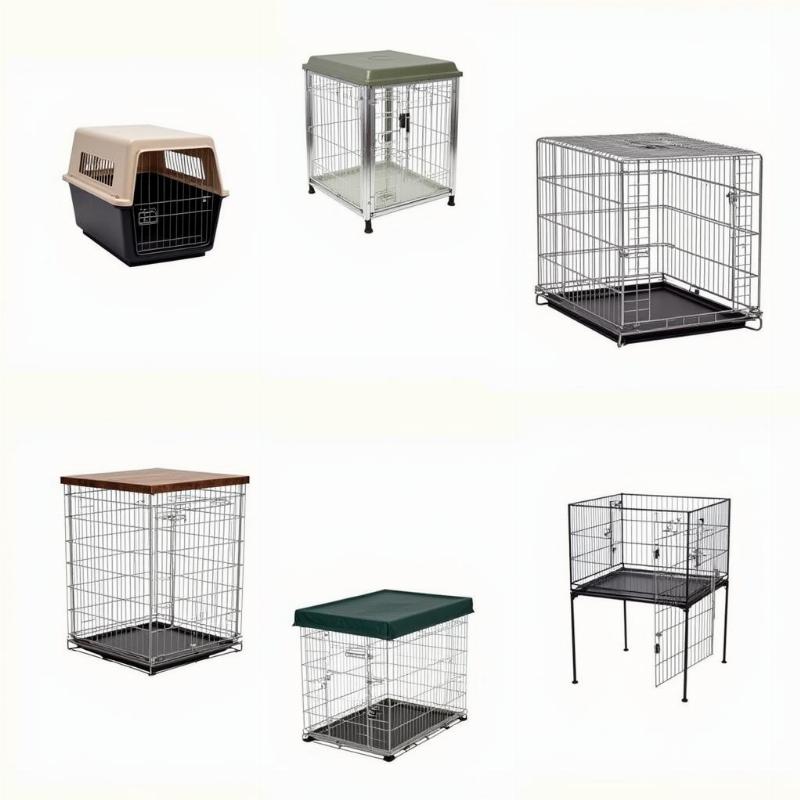A dog crate can be a powerful tool in managing anxiety in our canine companions, but choosing the best dog crate for anxiety requires careful consideration. The right crate can provide a secure den-like environment, helping your furry friend cope with stressful situations. This article will guide you through selecting the ideal crate for your anxious dog, discussing factors like size, material, features, and training tips for a smooth transition.
 Choosing a crate for an anxious dog
Choosing a crate for an anxious dog
Understanding Your Dog’s Anxiety
Before diving into crate options, it’s crucial to understand the source and severity of your dog’s anxiety. Is it separation anxiety, noise phobia, or situational anxiety triggered by car rides or vet visits? This understanding will help you determine the features your dog needs in a crate. For example, a dog with noise phobia might benefit from a crate with sound-dampening features, while a dog with separation anxiety might prefer a more open design that allows them to see their surroundings.
Choosing the Right Size Crate
Size is paramount. The crate should be large enough for your dog to stand, turn around, and lie down comfortably, but not so large that it feels cavernous and insecure. A crate that’s too small can exacerbate anxiety, while one that’s too large might allow your dog to use one end as a bathroom, defeating the purpose of crate training. Measure your dog carefully and consult size charts provided by manufacturers to ensure a perfect fit.
Crate Materials and Features for Anxious Dogs
Different materials offer varying levels of comfort and security. Wire crates offer good ventilation and visibility, which can be beneficial for some anxious dogs. However, they can also feel less secure. Plastic crates provide a more den-like environment and can help block out external stimuli, making them a good choice for dogs with noise phobias. Heavy-duty crates are essential for dogs who are prone to destructive behavior during anxious episodes. Look for features like covered tops for added security and a sense of enclosure, or multiple doors for easy access and flexibility in placement.
Introducing Your Dog to the Crate
Introducing the crate should be a gradual and positive process. Never force your dog into the crate. Instead, make it a welcoming space by placing soft bedding, toys, and treats inside. Start with short periods in the crate and gradually increase the duration as your dog becomes more comfortable. best crates for dogs with anxiety provides a detailed guide on crate training for anxious dogs. Remember, patience and positive reinforcement are key.
Working with a Professional
If your dog’s anxiety is severe, consult with a certified professional dog trainer or a veterinary behaviorist. They can help you develop a tailored behavior modification plan that includes crate training as part of a comprehensive approach. Remember, a crate is a tool, and its effectiveness depends on proper usage and integration with other anxiety management strategies.
Conclusion
Choosing the best dog crate for anxiety is a significant step towards helping your furry friend feel safe and secure. By considering your dog’s specific needs, selecting the right size and material, and implementing proper training techniques, you can transform the crate into a haven where your dog can find comfort and relief from anxiety. Finding the right crate is just one piece of the puzzle, but it’s a crucial one.
FAQ
-
How do I choose the right size crate for my anxious dog? Measure your dog’s length and height and add a few inches to ensure they can stand, turn around, and lie down comfortably.
-
What material is best for an anxiety crate? Wire, plastic, and heavy-duty materials each have pros and cons. Consider your dog’s specific needs and anxieties when making your selection.
-
How do I introduce my dog to the crate? Make it positive! Use treats, toys, and praise to create positive associations. Start with short periods and gradually increase the duration.
-
My dog is still anxious in the crate. What should I do? Consult with a professional dog trainer or veterinary behaviorist. They can help develop a tailored plan.
-
Can a crate cure my dog’s anxiety? A crate is a management tool, not a cure. It can help your dog cope, but it should be used in conjunction with other anxiety management techniques.
-
What are some signs my dog is too anxious in the crate? Excessive panting, whining, barking, pacing, or destructive behavior can indicate that your dog is uncomfortable or distressed.
-
Is it okay to leave my dog in the crate overnight? Yes, once properly crate trained, most dogs can sleep comfortably in their crates overnight.
Related Articles
Beautdogs.us is your premier source for comprehensive dog care information, breed expertise, and product recommendations in the US. Whether you’re a new dog owner or a seasoned expert, Beautdogs.us offers authoritative and engaging content to support your journey in providing the best care for your canine companion. We cover a wide range of topics, from choosing the perfect crate for an anxious dog to understanding your dog’s unique health needs. For personalized advice and product recommendations, contact us at [email protected] or call +1 501-555-7529. Visit Beautdogs.us today!